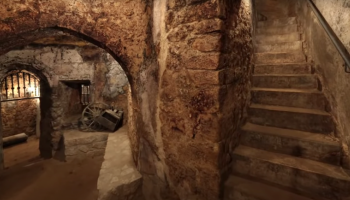THE ARCHITECTURE OF WINE

Traditional architecture
More than thousand years of history prove the presence of our wines in Ribera del Duero. From the time of the Vaccaei and, later, the Romans, wine-making has been one of the principal agricultural activities in the area. With the coming of the Middle Ages and the monasteries as the main promotors of making wine, thanks to their knowledge and resources, the first underground cellars began to be dug in different towns and villages. These galleries, many of them decorated with dressed stone and Arabian brick, were carved out by the hands of men. They were approximately 9-14 metres deep, making it possible to considerably increase wine production and to export it to other regions.
Nowadays most underground cellars have a private or tourist use and many of them, converted into other types of business like wine shops, museums or even restaurants, can be visited. However, there are still wineries that continue to make their products in these temples to wine-making. This other town exists for the pleasure of the senses underneath the villages of the Duero.
Avant-garde architecture
Wine, like architecture and design, is also an art form. Because of this, over the last few years, many wineries have shown their concern for the innovation and modernisation of their facilities, not just in wine-making mechanisms but also the image of the wineries themselves.
These contemporary works combine the functionality needed for working with the look and feel of the building, turning it into a true monument to wine.
Great architects have been responsible for the most outstanding works and, on the Ribera del Duero Wine Route, we can boast of having two of them: Bodegas Portia and Bodegas Protos.
In the town of Gumiel de Izán (Burgos) is Bodegas Portia, the fourth generation of the Faustino Group. Norman Foster’s architecture studio was responsible for the building, where works began in 2006. It is a winery in perfect harmony with the landscape, with a star-shaped floor plan, bringing together fine materials like steel, glass and, of course, oak. It is a firm commitment to wine tourism that has helped position it as one of the leading avant-garde wineries in the world.
Continuing along Ribera del Duero, you reach the town of Peñafiel (Valladolid) where, below its castle, Bodegas Protos awaits us. Considered to be the first winery operating in Ribera del Duero, Protos combines tradition with the avant-garde. Visiting it, you begin with the network of underground galleries carved into the slope of the castle hill, moving along tunnels in the rock leading to the new building designed by Sir Richard Rogers as if you were travelling in time. Its large rooms flooded with light are dressed in glass and wood to preserve its most prized asset: the wine.
Caleruega
Gumiel de Izán
Aranda de Duero
San Esteban de Gormaz
Aranda de Duero
Vadocondes










